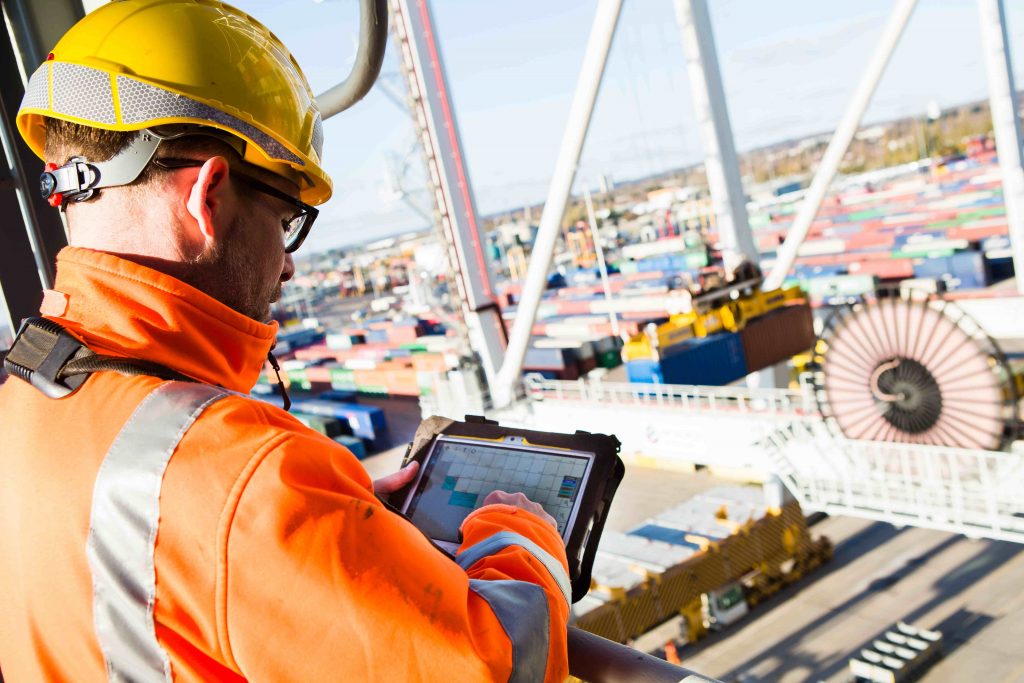Case Study: Real Time Mobile Interaction with Vessel Loading and Discharge
20th February 2020

“No terminal in the UK or Europe uses a mobile device with software as advanced that enables an operator to interact with the loading and discharging of a vessel in real time.” Ports operator DP World is using Panasonic TOUGHBOOK rugged notebooks and tablets, purchased through Colva Ltd, to transform productivity and customer service at its busy Southampton terminal operation.
Initially DP World Southampton was looking for a mobile computing solution for its Leading Hands, who take responsibility to ensure the safe and correct loading and discharging of containers on each vessel visiting the terminal.
“Up until this point Leading Hands had used paper-based crane work lists and bay plans, which were out of date as soon as they were printed,” explained Mark Hooper, Head of Operations, DP World Southampton. “Changes the Leading Hand made would be written down and communicated back and forth over the radio. Working in all weathers, day and night, the paperwork could be damaged, illegible, confusing, weather worn, returned late or lost.”
After reviewing a range of rugged devices, DP World’s IT experts, in consultation with end users, chose the Panasonic TOUGHBOOK G1 rugged tablet for the job and built their own software programme to provide the Leading Hands with live data and autonomy to make onsite decisions which, in turn, improved productivity and drove down costs. After a successful trial on one berth, the package was introduced across the whole terminal (15 quay cranes).
“The Leading Hand can now pick which bay on the vessel to work and interact to confirm container positions. No other terminal uses a mobile device with software as advanced that enables an operator to interact with the loading and discharging of a vessel in real time, improving crane rates, shortening vessel stays, as well as providing more up to date information for shippers,” explained Mr Hooper.
Since introduction the quay crane move rate has increased, meaning ships have shorter stays and can travel to their next port sooner. Live updates coming back from the Leading Hand also provides improved information, which is passed through to the customer via the DP World Southampton “Where’s my container?” website.
The application continually receives updates from the Panasonic TOUGHBOOK tablet, which juggles between 4G and Wi-Fi connections to ensure connectivity is maintained. With tall metal super-structures like quay cranes and walls of stacked containers hindering service strength and signal, the terminal worked with Panasonic partner NetMotion to ensure workers could stay connected through their devices.
Extreme conditions can also impact on the worker’s ability to view and operate the screen on the mobile device. With the Panasonic TOUGHBOOK tablets, the user can toggle from a normal touch-screen operation to a stylus only mode; enabling work to continue in the most difficult conditions.
In addition to the Leading Hand solution, DP World has also equipped its straddle carriers, vehicles which move and stack the shipping containers, with Panasonic TOUGHBOOK 33 rugged notebooks. The Panasonic ProServices team also designed and delivered a bespoke docking unit for the devices to ensure the solution could be used easily and safely in the specialist vehicles.
Lastly, the DP World maintenance teams use Panasonic TOUGHBOOK 20 and 33 rugged notebooks as essential tools for running diagnostics and managing maintenance tasks on vehicles at the terminal.
Following the success of the deployment, other DP World terminals have either rolled out or are considering Panasonic TOUGHBOOK solutions, along with other sites around Europe and the rest of the world. And customers are recognising the benefits of the new solution.
Darren Munday, Transport & Manufacturing Business Manager for Panasonic TOUGHBOOK, said: “Container shipping operations, such as the one at DP World Southampton, are some of the most complex and extreme conditions for operating mobile computing devices. By working closely with our professional services team and application partners, Panasonic has been able to deliver a range of mobile computing solutions for DP World that has helped improved productivity, as well as the customer service and user experience.”

